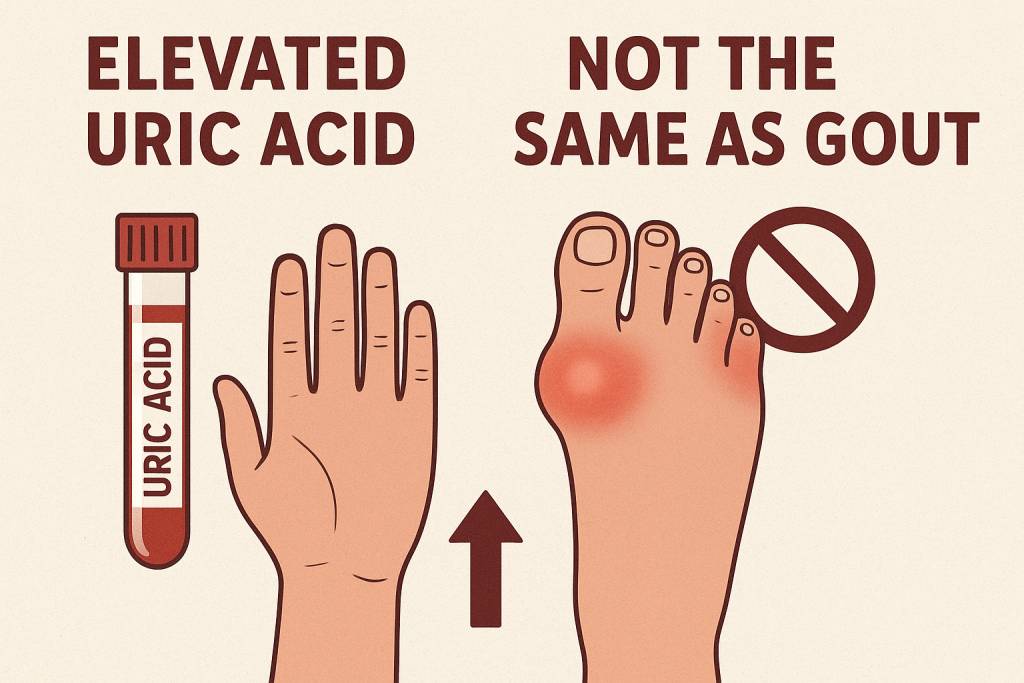
A routine blood test reveals an unexpected result: your uric acid levels are elevated. Immediately, your mind might jump to the worst-case scenario—excruciating joint pain, swollen toes, and a diagnosis of gout. It’s a common fear, but it’s crucial to understand a key distinction: high uric acid is not the same as gout.
Having high uric acid, a condition called hyperuricemia, is a significant risk factor, but it is not the disease itself. Many people live with elevated uric acid for years without ever experiencing a single symptom. Gout is what happens when this condition progresses to the point of causing a painful inflammatory response.
Understanding the journey from a simple blood test result to a clinical diagnosis is the first step toward taking control of your health. This article will guide you through the four distinct stages of this progression, clarifying the risks at each step and outlining a proactive strategy—including lifestyle choices and targeted nutritional support from brands like BISPIT—to help you manage your health effectively.
The Critical Distinction: Hyperuricemia vs. Gout
Before diving into the stages, let’s clarify the two key terms:
- Hyperuricemia: This is the clinical term for having high levels of uric acid in your blood (typically above 6.8 mg/dL). Uric acid is a natural waste product from the breakdown of purines, which are found in your body’s cells and in many foods. Hyperuricemia occurs when your body either produces too much uric acid or your kidneys don’t excrete it efficiently. It is a biochemical state, not a disease.
- Gout: This is a painful form of inflammatory arthritis. Gout is the disease that occurs when chronic hyperuricemia leads to the formation of sharp, needle-like monosodium urate crystals in a joint or surrounding tissue, triggering a severe inflammatory attack.
Think of it this way: hyperuricemia is like having high cholesterol. It’s a silent risk factor. Gout is like the heart attack that can result if that high cholesterol is left unmanaged.
The Journey to Gout: Understanding the 4 Stages
The progression from a silent metabolic imbalance to a painful disease is not instantaneous. It typically occurs over time and can be broken down into four distinct phases.
This is precisely where most people are when they first discover their uric acid is high.
- What’s Happening: Your blood tests show elevated uric acid levels, but you feel completely fine. You have no joint pain, no swelling, and no symptoms of gout.
- The Hidden Danger: Although you are “asymptomatic,” the underlying process may have already begun. According to a review in The Lancet, even at this early stage, the supersaturated uric acid in your blood can begin to slowly form microscopic crystals in your joints, particularly in cooler areas of the body like the big toe. You just can’t feel them yet.
- The Opportunity: This is the most crucial stage for prevention. Because there is no pain, it’s easy to ignore the warning sign from your blood test. However, this is the golden window to adopt proactive lifestyle changes to lower your uric acid levels and potentially prevent ever progressing to the next stage.
This is the stage that everyone associates with gout. It is the painful manifestation of the underlying hyperuricemia.
- What’s Happening: Something—be it a high-purine meal, dehydration, or stress—triggers a rapid change in your uric acid level. This causes the monosodium urate crystals that have been silently depositing in a joint to shed into the joint space. Your body’s immune system recognizes these sharp crystals as foreign invaders and launches a massive inflammatory attack.
- The Symptoms: The result is a sudden and excruciating onset of symptoms, often at night:
- Intense, crushing pain in a single joint (the big toe is affected in over 50% of first attacks).
- Significant swelling and inflammation.
- Extreme tenderness—even the weight of a bedsheet can be unbearable.
- Red or purplish, shiny skin over the affected joint.
- Duration: An acute flare can last for several days to a couple of weeks if left untreated. Prompt treatment with anti-inflammatory medication is key to shortening its duration.
After the agony of an acute flare subsides, you enter the intercritical period.
- What’s Happening: You are once again symptom-free. The pain and swelling are gone, and you might feel like the problem has disappeared.
- The Deceptive Calm: This is a dangerously misleading phase. While the inflammation has calmed down, your uric acid levels are likely still elevated. Urate crystals are continuing to silently accumulate in your joints, setting the stage for the next attack. According to the American College of Rheumatology, without proper management, patients will likely experience another flare within a year. The frequency and severity of these attacks often increase over time.
This is the final and most debilitating stage of the disease, resulting from years of unmanaged or poorly managed hyperuricemia.
- What’s Happening: The urate crystal deposits have grown so large that they have formed into chalky, white nodules called tophi.
- The Symptoms: These tophi are visible lumps that can appear under the skin around joints, in the earlobes, and along tendons. They are not typically painful themselves, but they cause:
- Chronic, persistent joint pain and stiffness.
- Severe joint damage and erosion, leading to permanent deformity.
- Limited range of motion and significant disability.
- Preventable Consequences: Chronic tophaceous gout is a clear sign of long-term, uncontrolled hyperuricemia. The good news is that with modern treatments and proactive management, this stage is almost entirely preventable.
From Prevention to Management: Taking Control at Every Stage
Understanding these stages empowers you to act. The goal is to halt the progression as early as possible.
1. The Power of Proactive Lifestyle Choices
This is your first line of defense, especially in Stage 1.
- Dietary Adjustments: Limit high-purine foods like organ meats, red meat, and certain seafood. Reduce intake of sugary drinks and alcohol, especially beer.
- Hydration is Key: Drinking plenty of water helps your kidneys flush uric acid out of your system, as recommended by the Arthritis Foundation.
- Maintain a Healthy Weight: Losing excess weight can significantly lower your uric acid levels and reduce stress on your joints.
2. The Role of Targeted Nutritional Support
A proactive lifestyle can be powerfully enhanced with scientifically formulated nutritional support. This is where a brand like BISPIT comes in. BISPIT is dedicated to developing natural solutions for individuals navigating the challenges of high uric acid. Their products are designed with high-purity, natural extracts that work synergistically with your body to help maintain a healthy uric acid balance. Incorporating a trusted supplement into your daily routine, especially during the silent asymptomatic stage, is a smart, proactive step towards long-term wellness and preventing the progression to painful flares.
3. When to Consult a Doctor
If you experience a gout flare or your uric acid levels remain consistently high despite lifestyle changes, it is essential to see a doctor. They may recommend urate-lowering therapy (ULT), which is the most effective way to lower uric acid levels and prevent the long-term consequences of gout.
Conclusion: Your High Uric Acid Level is a Warning, Not a Verdict
Receiving a high uric acid test result can be alarming, but it is not a diagnosis of gout. It is a crucial warning sign and, more importantly, an opportunity to take control.
By understanding the four stages—from the silent warning of asymptomatic hyperuricemia to the preventable damage of chronic gout—you can make informed decisions. A proactive approach combining a smart diet, regular exercise, proper hydration, and the targeted support of a high-quality supplement like BISPIT can help you manage your uric acid levels effectively. This comprehensive strategy is your best defense against ever having to experience the painful reality of a gout attack, allowing you to focus on living a healthy, active, and pain-free life.
References
- Dalbeth, N., Merriman, T. R., & Stamp, L. K. (2016). Gout. The Lancet, 388(10055), 2039–2052.
- FitzGerald, J. D., Dalbeth, N., Mikuls, T., et al. (2020). 2020 American College of Rheumatology Guideline for the Management of Gout. Arthritis & Rheumatology, 72(6), 879–895.
- Mayo Clinic. (2021). Gout. Retrieved from https://www.mayoclinic.org/diseases-conditions/gout/symptoms-causes/syc-20372897
- Ragab, G., Elshahaly, M., & Bardin, T. (2017). Gout: An old disease in new perspective – A review. Journal of Advanced Research, 8(5), 495–511.
